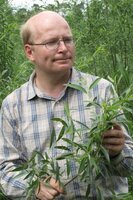Dr. Ben Bubner

Institute of Forest Genetics
Eberswalder Chaussee 3a15377 Waldsieversdorf
- Telephone
- +49 33433 157 150
- Fax
- +49 33433 157 199
- Telephone
- +49 33433 157 170
- Fax
- +49 33433 157 199
- ben.bubner@thuenen.de
Research fellow in the Field of Activity ‘Provenance and Breeding Research’, Project ‘ResEsche’
1996-2003 Studies in Biology (Diplom) at the Friedrich-Schiller-Universität Jena, major in botany, minors in biochemistry and biophysics
2004-2005 Scientific employee at the Max Planck Institute for Chemical Ecology Jena: Measurement of nuclear DNA content of transgenic Nicotiana attenuata and wild types of related Nicotiana species.
2005-2008 Scientific employee at the Leibniz Centre for Agricultural Landscape Research Müncheberg: Biodiversity of ectomycorrhiza in forest transformation, funded by the Deutsche Forschungsgemeinschaft
2008-2011 Scientific employee at Leibniz Centre for Agricultural Landscape Research Müncheberg: Impact of multi-resistant transgenic Bt maize on straw decomposition and the involved microbial communities, funded by the German Federal Ministry of Education and Research
2012-2015 Scientific employee at the Thünen Institute of Forest Genetics, branch Waldsieversdorf: Breeding of new willow clones (Salix spp.) and selection for resistance against willow rusts (Melampsora spp), funded by the German Agency for Renewable Resources
2013 Dissertation, Dr. rer. nat. at the Brandenburg Technical University Cottbus: Host specificity and biodiversity of ectomycorrhizal fungi in pure and mixed stands of Scots pine (Pinus sylvestris L.) and beech (Fagus sylvatica L.)
Since 2015 Scientific employee at the Thünen Institute of Forest Genetics, branch Waldsieversdorf: Selection of Alnus glutinosa for resistance against Phytophthora alni, funded by the German Agency for Renewable Resources
Since 2016 Scientific employee in the project "ResEsche"
Publications
- 0
Bubner B, Past F, Fussi B, Seidel H, Rentschler F, Körtels E, Dreist M, Fey C, Wolf H, Steinigen T, Siemokat P, Ridley M (2023) Deutschlandweite Selektion und Testung von Eschen (Fraxinus excelsior L.) mit Toleranz gegenüber dem Eschentriebsterben: Ergebnisse mit Genotypen aus der Pfropfsaison 2022. Julius Kühn Arch 475:328-329
- 1
Krautwurst M, Past F, Kersten B, Bubner B, Müller NA (2023) Identification of full-sibling families from natural single-tree ash progenies based on SSR markers and genome-wide SNPs. Cold Spring Harbor: bioRxiv, 15 p, DOI:10.1101/2023.07.18.549475
- 2
Eisold A-M, Bandte M, von Bargen S, Büttner C, Bubner B (2023) Risiken für Wald und Forst durch phytopathogene Viren. Julius Kühn Arch 475:494-495, DOI:10.5073/20230803-074309-0
- 3
Krautwurst M, Past F, Bubner B, Müller NA (2023) Vollgeschwisteranalysen von Eschen Plusbäumen zur Aufklärung der genetischen Grundlagen von Unterschieden im Eschentriebsterben. Ber Freiburger Forstl Forsch (106):35-39
- 4
Past F, Schneck V, Bubner B, Schrader M, Röhe P (2022) Chancen für eine gefährdete Baumart. Land Forst 175(19):44-46
- 5
Langer GJ, Fuchs S, Osewold J, Peters S, Schrewe F, Ridley M, Kätzel R, Bubner B, Grüner J (2022) FraxForFuture - research on European ash dieback in Germany. J Plant Dis Protect 129(6):1285-1295, DOI:10.1007/s41348-022-00670-z
- 6
Schneck V, Bubner B, Past F, Eisold A-M (2022) ResEsche - Ein Beitrag zur Rettung der Esche. Großhansdorf: Thünen-Institut für Forstgenetik, 2 p, Project Brief Thünen Inst 2022/27, DOI:10.3220/PB1658736221000
- 7
Schneck V, Bubner B, Past F, Eisold A-M (2022) ResEsche - Research for survival of common ash in Germany. Grosshansdorf: Thünen Institute of Forest Genetics, 2 p, Project Brief Thünen Inst 2022/27a, DOI:10.3220/PB1658736609000
- 8
Scholler M, Braun U, Buchheit R, Schulte T, Bubner B (2022) Studies on European rust fungi, Pucciniales: molecular phylogeny, taxonomy, and nomenclature of miscellaneous genera and species in Pucciniastraceae and Coleosporiaceae. Mycol Progr 21:64, DOI:10.1007/s11557-022-01810-3
- 9
Past F, Schrader M, Bubner B, Schneck V, Röhe P (2021) Forschungsprojekt "ResEsche" - Chance für die Baumart Esche. AFZ Der Wald 76(8):12-16
- 10
Scholler M, Bubner B, Buchheit R (2021) Rostpilze (Pucciniales) und Nacktbasidien (Exobasidiales). SchrR Forsch Nationalpark Schwarzwald 1:89-110
- 11
Past F, Bubner B, Mewis I (2020) Erste Experimente zum Einfluss von Sphinx ligustri L. auf das In-vitro-Wachstum und den Hormonhaushalt in den Blättern von Fraxinus excelsior L.. Thünen Rep 76:182-200
- 12
Gouker FE, DiFazio SP, Bubner B, Zander M, Smart LB (2019) Genetic diversity and population structure of native, naturalized, and cultivated Salix purpurea. Tree Genetics Genomes 15:47, DOI:10.1007/s11295-019-1359-0
- 13
Bubner B, Buchheit R, Friedrich F, Kummer V, Scholler M (2019) Species identification of European forest pathogens of the genus Milesina (Pucciniales) using urediniospore morphology and molecular barcoding including M. woodwardiana sp. nov.. MycoKeys 48:1-40, DOI:10.3897/mycokeys.48.30350
- 14
Bubner B, Köhler A, Zaspel I, Zander M, Förster N, Gloger J, Ulrichs C, Schneck V (2018) Breeding of multipurpose willows on the basis of Salix daphnoides Vill., Salix purpurea L. and Salix viminalis L.. Landbauforsch Appl Agric Forestry Res 68(1-2):53-66, DOI:10.3220/LBF1538634874000
- 15
Becker R, Bubner B, Remus R, Wirth S, Ulrich A (2014) Impact of multi-resistant transgenic Bt maize on straw decomposition and the involved microbial communities. Appl Soil Ecol 73:9-18, DOI:10.1016/j.apsoil.2013.08.002
- 16
Bubner B, Wunder S, Zaspel I, Zander M, Gloger J, Fehrenz S, Ulrichs C (2014) Melampsora rust species on biomass willows in central and north-eastern Germany. Fungal Biol 118(11):910-923, DOI:10.1016/j.funbio.2014.08.002
- 17
Bubner B, Morgner C, Stark W, Münzenberger B (2014) Proof of ectomycorrhizal status of Sistotrema confluens Pers., the type species of the polyphyletic genus Sistotrema. Mycol Progr 13(4):1235-1239, DOI:10.1007/s11557-014-0973-3
- 18
Bubner B, Zander M, Zaspel I, Ulrichs C (2014) Unterscheidung von Rostpilzen an Biomasseweiden. AFZ Der Wald 69(5):40-43
- 19
Bubner B, Fladung M, Lentzsch P, Münzenberger B, Hüttl RF (2013) Individual tree genotypes do not explain ectomycorrhizal biodiversity in soil cores of a pure stand of beech (Fagus sylvatica L.). Trees 27(5):1327-1338, DOI:10.1007/s00468-013-0881-1
- 20
Münzenberger B, Bubner B, Wöllecke J, Sieber TN, Bauer Robert, Fladung M, Hüttl RF (2009) The ectomycorrhizal morphotype Pinirhiza sclerotia is formed by Acephala macrosclerotiorum sp. nov., a close relative of Phialocephala fortinii. Mycorrhiza 19(7):481-492, DOI:10.1007/s00572-009-0239-0

![[Translate to English:] [Translate to English:]](/media/_processed_/f/3/csm_2022_Titelbild_gross2_Saatgut_in_Hand_9ffb8f5748.jpg)
![[Translate to English:] [Translate to English:]](/media/_processed_/f/3/csm_2022_Titelbild_gross2_Saatgut_in_Hand_c17270fcc0.jpg)
![[Translate to English:] Logo des Bundesministerium für Ernährung und Landwirtschaft](/media/allgemein/logos/BMEL_Logo.svg)